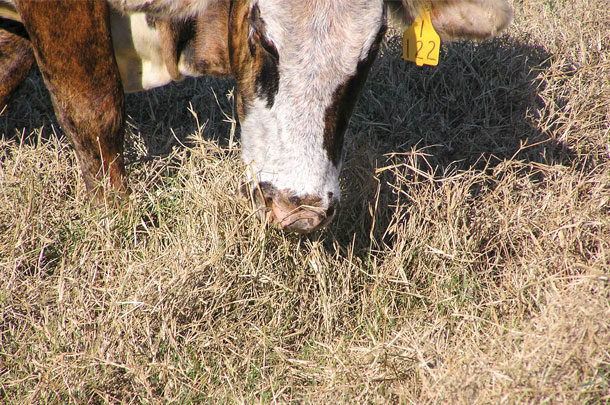Stockpiling warm-season perennials (bermudagrass or bahiagrass) or planting winter pastures are among these options and are often a more profitable solution for livestock operations. I will explain each and their required management.
Stockpiling
In this system, forages are allowed to accumulate in the field during fall and early winter. Stockpiled bermudagrass can provide the required nutrition for dry, pregnant cows through January, if the appropriate procedure is followed. Producers should plan on providing approximately 45 to 60 days of grazing with the dormant bermudagrass. In most instances, stockpiled bermudagrass should be used up by January. Once the stockpiled bermudagrass is completely grazed, a shift to another winter-feeding option is required.
Adequate moisture combined with appropriate fertilization is required to produce the desired bermudagrass quantity and nutritive value. If fertilizer is not applied after cutting or grazing in August, producers may still take advantage of accumulated forage during the fall. There will not be as much forage accumulated and forage nutritive value will be lower. The forage, however, may still be utilized, providing appropriate supplementation is provided. If adequate moisture is not received during September, October and November, little bermudagrass will be produced and grazing initiation may be delayed.
Steps to stockpile bermudagrass and bahiagrass include:
- Graze pasture to a 2 to 3 inch stubble height, or harvest the final cutting of hay in preparation for fertilization approximately eight weeks prior to first anticipated frost.
- Apply 60 to 75 pounds of nitrogen. Phosphorus and potassium should be applied based on soil test recommendations.
- Defer pastures from grazing and allow forage to accumulate until frost or forage is needed.
- Initiate grazing in response to the need for hay supplementation.
- When stockpiled forage is completely grazed, it will be time to start traditional hay-feeding program or initiate grazing cool-season forages.
- Be sure to provide free-choice mineral supplement to cattle and monitor body condition.
Winter pasture
Along with stockpiled forage, utilization of winter pastures can help reduce winter feeding costs. Planted winter pastures provide the highest quality forage that can be grown throughout the southeastern U.S. They include small grains, annual ryegrass and cool-season legumes. Grazing of winter pastures can extend from November through early June depending on location, varieties used, planting method and planting date. The type and amount of winter pasture used should be planned carefully because of the expense associated with land preparation, seed and fertilizer.
Oats, barley, wheat, rye, triticale and annual ryegrass are the annual grasses most often used for winter pastures. Rye is the most cold-tolerant followed by wheat, barley, ryegrass and oats. Rye is the earliest to mature followed by wheat, barley, oats and ryegrass. Ryegrass will provide four to six weeks extra grazing in the spring due to its later maturity. Therefore, ryegrass is the most productive. However, location, unusually cold temperatures, or dry conditions during different times of the growing season can alter the species ranking in production. Variety trial data is reported annually from universities throughout the Southeast.
Forage legumes such as clovers and vetch are also used for winter pasture. The advantages of a legume are that it doesn’t require nitrogen fertilizers since it can remove nitrogen from the air and it is very high-quality forage. The disadvantage of cool-season legumes is that 75% to 90% of the total forage production does not occur until spring. For this reason, ryegrass is mixed with clover to provide earlier forage production.
Management
Estimating how many acres to establish is dependent on class of animal and local climate. The actual stocking rate might be higher or lower depending on weather and management. A pasture should be stocked properly in the fall so there will be a carryover of forage into the winter when forage production is limited by cold, short, cloudy days. Proper stocking for fall and winter will result in excess forage in the spring. A producer needs to use this extra forage wisely. Additional livestock can be added in the spring, or the excess growth can be harvested for hay. In any case, excess spring growth on overseeded pastures should be utilized so the warm-season perennial grass is not crowded out.
Winter pasture should be planted from mid-September through October. Optimum planting dates will vary with location and type of winter pasture. Planting can begin earlier in more Northern locations because temperatures decrease sooner in early autumn. Earlier plantings result in greater early forage production if moisture is available. However, the earlier the planting, the higher the risk that the stand could be lost to drought. September plantings should be in prepared seedbed to reduce weed and grass competition and provide good placement of seed in the soil. Summer pastures should be overseeded in October and early November depending on location. The warm-season grass should be mowed or grazed short (2 to 3 inches) to reduce competition.
Management practices such as disking and short sod height enhances early forage production of overseeded winter forages. However, these practices slow down spring recovery of the warm-season perennial grass. A three-year study at the Texas A&M AgriLife Research and Extension Center at Overton has shown that autumn sod treatments hindered Coastal bermudagrass recovery even if not overseeded. Disking reduced bermudagrass yields by an average of 600 to 700 pounds per acre through mid to late June. The 1-inch sod height reduced yields an average of 500 pounds per acre when overseeded with clover, and 250 pounds per acre when overseeded with ryegrass or not overseeded, compared to the four-inch sod height. Coastal bermudagrass not overseeded was overgrown with winter weeds.
Fertilization of winter pasture should be based on a soil test to maximize production and prevent applying excess fertilizer. Soil analysis will also provide the soil pH, which is especially critical in sandy soils. Ryegrass requires a minimum pH of 5.7 and clover a pH of 6.0 for good fertilizer utilization and forage production. Lime needs to be applied in the spring to raise soil pH by fall.
All forage intended for fall and winter does not have to be harvested as hay. Alternative management strategies that target grazing in stockpiling forages can minimize hay feeding. The amount of forage that can be stockpiled will be dependent on fertilization and weather. Winter pastures can be a profitable component of pasture systems throughout the southeastern U.S. Their greatest attribute is the production of a high-quality forage that is superior to warm-season forages.
To be profitable, attention must be paid to variety selection, planting dates, seeding rates, fertilizer and proper utilization. Winter pastures can reduce the amount of hay and supplements needed during the winter-feeding period and provide spring weed control. ![]()
PHOTO: A cow grazes stockpiled bermudagrass. Photo provided by Dr. Monte Rouquette Jr.
References omitted but are available upon request. Click here to email an editor.

-
Vanessa Corriher-Olson
- Associate Professor and Extension Forage Specialist
- Texas A&M AgriLife Research and Extension Center
- Email Vanessa Corriher-Olson









